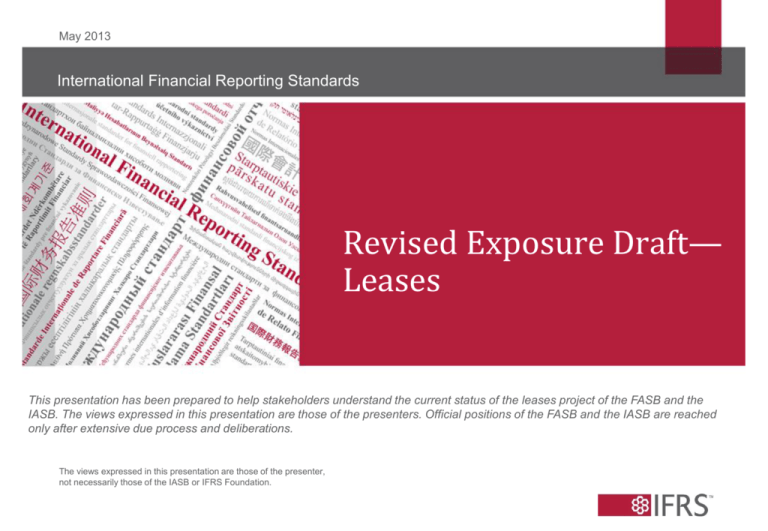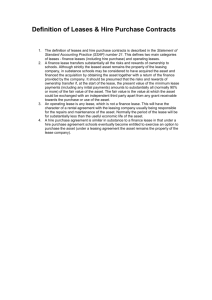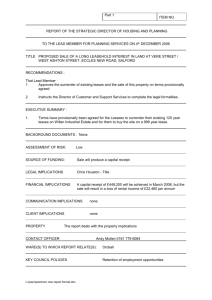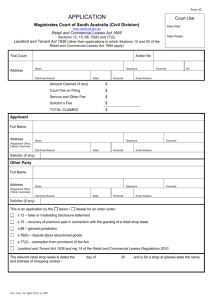Title / divider screen title
advertisement

May 2013 International Financial Reporting Standards Revised Exposure Draft— Leases This presentation has been prepared to help stakeholders understand the current status of the leases project of the FASB and the IASB. The views expressed in this presentation are those of the presenters. Official positions of the FASB and the IASB are reached only after extensive due process and deliberations. The views expressed in this presentation are those of the presenter, not necessarily those of the IASB or IFRS Foundation. Presenters for Today’s Webcast Darrel Scott, IASB member Patrina Buchanan, Technical Principal Sarah Geisman, Technical Manager © 2012 IFRS Foundation. 30 Cannon Street | London EC4M 6XH | UK. www.ifrs.org 2 Housekeeping Items 3 • Download slides by clicking on the button below the slides window • Ask a question by typing into the designated text box on your screen and clicking “submit” • Remember to turn off your pop-up blocker • A webcast recording will be available online at www.ifrs.org for 90 days © 2012 IFRS Foundation. 30 Cannon Street | London EC4M 6XH | UK. www.ifrs.org Leases ED is Available 4 • The documents are available online at www.ifrs.org • The comment period ends on 13 September 2013 • Send comments electronically to the IASB website (www.ifrs.org) using the “Comment on a Proposal” page © 2012 IFRS Foundation. 30 Cannon Street | London EC4M 6XH | UK. www.ifrs.org Agenda • Background • Lessee accounting • Lessor accounting • Other aspects • Next steps 5 Why a Leases project? Lessee • Most assets and liabilities are offbalance-sheet • Limited information about operating leases Lessor • Lack of transparency about residual values • Consistency with lessee proposals and revenue proposals 6 $1.25 trillion of off-balancesheet operating lease commitments for SEC registrants* * Estimate according to the 2005 SEC report on off-balance-sheet activities How the proposals are an Improvement Existing accounting issues Lessee Most assets and liabilities are offbalance-sheet Insufficient disclosure Lessee about operating leases Lessor Lack of transparency about residual values of equipment and vehicles The proposals Recognition of lease assets and liabilities for all leases of more than 12 months Enhanced disclosure requirements Separately account for residual asset Enhanced disclosures about residual asset’s exposure to risk 7 How the proposals are an improvement Greater transparency about leverage, assets used in operations, and cash flows Greater transparency about residual values Proposed right-of-use model 8 A lease contract conveys the right to use an asset (the underlying asset) for a period of time in exchange for consideration Right-of-use asset Lessor Lessee Lease payments Dual approach 9 There is a wide spectrum of lease transactions with different economics Start of lease 5-year lease Most equipment/ vehicles Asset consumption more than insignificant Most real estate Asset consumption not more than insignificant End of lease Lease classification test Leases for equipment/vehicles are Type A leases unless • Lease term is insignificant relative to total economic life of asset • Present value of lease payments is insignificant relative to fair value of asset 10 Leases for real estate are Type B leases unless • Lease term is major part of remaining economic life of asset • Present value of lease payments is substantially all of fair value of asset Lessee accounting model Balance sheet Type A Type B Most leases of equipment/ vehicles Right-of-use asset Lease liability Most leases of real estate Right-of-use asset Lease liability 11 Income statement Amortisation Interest expense Single lease expense on a straight-line basis Cash flow statement Cash paid for principal and interest payments Cash paid for lease payments Lessee disclosures Qualitative General description of leases Terms of: - variable lease payments -extension/termination options -residual value guarantees 12 Quantitative Judgements & Risks Maturity analysis of undiscounted cash flows for each of first 5 years plus total thereafter Nature and extent of risks arising from leases Reconciliation of lease liability* Restrictions and covenants Expense relating to variable lease payments Information about leases not yet commenced Reconciliation of right-ofuse asset by asset class Significant assumptions and judgement Lessor accounting model Balance sheet Type A Type B Most leases of equipment/ vehicle Lease receivable Residual asset Most leases of property Continue to recognise underlying asset 13 Income statement Interest income and any profit on the lease Lease income, typically on a straight-line basis Cash flow statement Cash received Cash received for lease payments Lessor disclosures Qualitative Quantitative General description of leases Reconciliation of lease receivable and residual asset 14 Judgements & Risks Nature and extent of risks arising from leases Table of lease income Terms of: -variable lease payments -extension/termination options -purchase options Maturity analysis undiscounted cash flows for each of first 5 years plus total thereafter Carrying amount of residual assets covered by residual value guarantees Significant assumptions and judgement Risk management for residual assets Reducing Cost and Complexity in Response to Feedback on the 2010 ED Short-term leases • Option to exclude leases with a maximum term of 12 months or less Variable lease payments • Excluded if payments are not linked to an index or a rate Renewal options • Excluded unless significant economic incentive to exercise the option © 2012 IFRS Foundation. 30 Cannon Street | London EC4M 6XH | UK. www.ifrs.org 15 Next steps 16 Revised EDMay 2013; Comment period ends13 September 2013 OutreachMay through October 2013 Redeliberationsbeginning Q4 2013 Final standard and effective dateTBD Thank you 17




